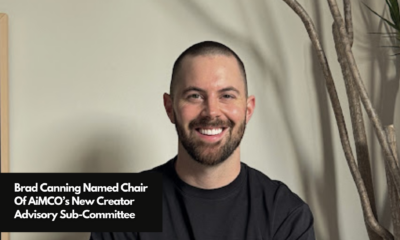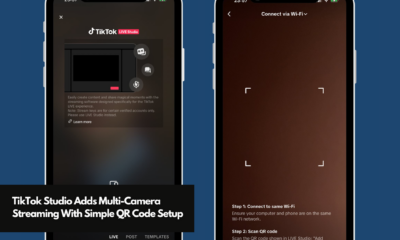-
Technology
Dutch Collabhouse Launches ‘Campaigns’ Feature Connecting Musicians With Content Creators
March 28, 2025Dutch music promotion platform Collabhouse has unveiled its new “Campaigns” feature, creating a marketplace for musicians...
-
Commentary
Circle Announces Creator Path Summit With 12 Industry Experts
March 28, 2025Circle, a community platform for creators and brands, is organizing the Creator Path Summit scheduled for...
-
Brand
LIV Golf Launches ‘The Duels’ Pairing Pro Golfers With YouTube Content Creators
March 28, 2025LIV Golf announces a new competition format that pairs professional golfers with popular content creators in...
-
Brand
BBC Abandons Podcast Ad Plans Following Gary Lineker’s Warning
March 28, 2025The BBC confirms it has abandoned plans to introduce advertisements on its radio programs and podcasts...
-
Technology
Spikerz: Protecting Digital Assets Amid The Rise Of AI
March 28, 2025In late 2024, a large-scale phishing operation affecting over 200,000 YouTube content creators was uncovered. The...
-
Platform
Trump Suggests Potential Tariff Reduction For China If They Approve TikTok Deal
March 28, 2025U.S. President Donald Trump indicates he may offer China tariff concessions if Beijing approves a deal...
-
Commentary
Utah Enacts New Legislation Protecting Children Of Influencers Following Ruby Franke Case
March 28, 2025Utah is implementing new protections for children of online content creators following the child abuse conviction...
-
Platform
TikTok Shop To Expand To France, Germany, And Italy
March 28, 2025TikTok Shop announced plans to launch in France, Germany, and Italy on Monday, extending its European...
-
Commentary
Former Dentsu Aegis CEO Jerry Buhlmann Joins Precise TV As Non-Executive Chairman To Drive U.S. Expansion
March 28, 2025Precise TV, the contextual video ad tech platform, has appointed Jerry Buhlmann as Non-Executive Chairman to...
-
Commentary
Brad Canning Named Chair Of AiMCO’s New Creator Advisory Sub-Committee
March 27, 2025Image: Brad Canning The Australian Influencer Marketing Council (AiMCO) has named award-winning content creator Brad Canning...
-
Platform
TikTok To Shut Down Photo-Sharing App Notes, Directs Users To Lemon8
March 27, 2025TikTok will discontinue its standalone photo-sharing application, Notes, on May 8, 2025, less than a year...
-
Platform
TikTok Expands Fact-Checking Operations Amid Global Election Challenges
March 27, 2025TikTok reports expansions in its misinformation and disinformation prevention capabilities across Europe in the second half...
-
Commentary
Support For TikTok Ban Down 16% In Two Years As Americans Weigh Security Concerns Against Free Speech
March 27, 2025Public support for banning TikTok in the United States has fallen over the past two years,...
-
Platform
TikTok Studio Adds Multi-Camera Streaming With Simple QR Code Setup
March 27, 2025TikTok is streamlining multi-camera live streaming capabilities through its TikTok Studio desktop application. The platform now...
-
Platform
Nielsen Report Shows YouTube Hitting Record TV Share of 11.6% In February, Surpassing Disney
March 27, 2025YouTube took the top position in Nielsen's February 2025 Media Distributor Gauge, gaining 2% over January...
-
Commentary
Report: Japanese Podcast Listeners Growing, Younger Demographic Tuning In
March 27, 2025The fifth "Podcast Report in Japan" survey reveals podcast usage reaching 17.2% of internet users in...
-
Talent Collectives
Creator-First Approach Makes All The Difference For Trend’s Growth
March 27, 2025Ted Raad’s wife Dede once turned down a brand deal worth more than his monthly corporate...
-
Technology
Pocket.watch: Helping YouTube Creators Build Global Franchises
March 27, 2025YouTube’s algorithm can make or break creators. For those who manage to build a following, what’s...
-
Technology
Tokchart: A Human-Centered Platform Focused On Creator Analytics
March 27, 2025The enterprise analytics platforms dominating creator tools often take months to implement requested features. Tokchart founder...
-
Brand
Pacsun Spotlights Fashion, Music At Rolling Loud California 2025 With Exclusive Livestream Content
March 26, 2025Pacsun expanded its presence in youth culture through multiplatform content initiatives at Rolling Loud California 2025,...
-
Agency
TryMus Group: Focusing On Long-Term Relationships And Content Depth In Influencer Marketing
March 26, 2025TryMus Group is a Toronto-based social media and influencer marketing agency launched in 2016 and specializes...
-
Brand
JCPenney Names VaynerMedia For Social And Influencer Marketing Amid Brand’s Transformation Initiatives
March 26, 2025JCPenney has appointed VaynerMedia as its social and influencer marketing agency of record as part of...
-
Influencer
Gen-Z Influencer Kat Abughazaleh Eyes Congressional Seat, To Leverage Social Media Platforms In Election Bid
March 26, 2025Kat Abughazaleh, a 26-year-old social media commentator known for her political content on TikTok, announced her...
-
Platform
YouTube To Test New Ad Feature For To Strengthen Position In Podcast Market
March 26, 2025YouTube is preparing to test a feature that would allow host-read advertisements to be dynamically inserted...
Connect with us
























































